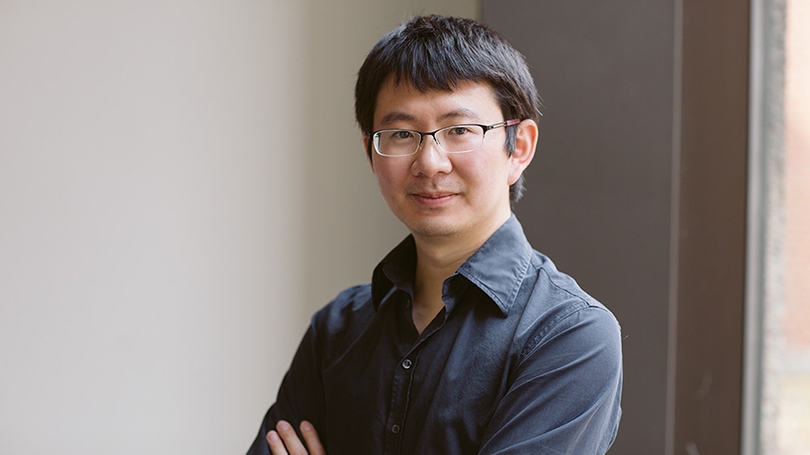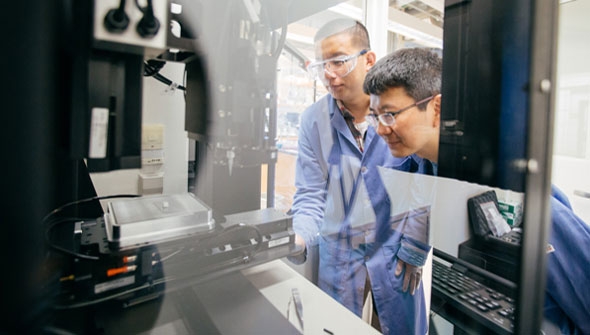
Assistant Professor of Chemistry Chenfeng Ke has been awarded a Faculty Early Career Development (CAREER) award from the National Science Foundation. (Photo by Robert Gill)
Ke’s laboratory team is at work developing a new type of porous, carbon-based crystal.
A material under development in a Dartmouth lab looks like a diamond and acts like a sponge. It is the result of Assistant Professor of Chemistry Chenfeng Ke’s research, and it has attracted the support of the National Science Foundation (NSF), which named Ke the winner of a Faculty Early Career Development (CAREER) award.
The prestigious award recognizes junior faculty who exemplify the role of teacher and researcher and have the ability to integrate the two. With over $600,000 in funding, the award provides five years of support for Ke’s research project.
Professor Dean Wilcox, chair of the Department of Chemistry, says Ke “is off to an excellent start in his academic career, not only developing novel materials but pursuing their commercial application and organizing an upcoming meeting on the 3-D printing method used for their synthesis. We are delighted with his success.”
The CAREER award will support Ke’s laboratory team’s work in developing a new type of porous, carbon-based crystal. While crystals are typically hard as a diamond, he describes these as having voids or spaces, being elastic and having the properties of a molecular-level sponge.
“Being porous and elastic, you can squeeze it and stretch it like a sponge,” says Ke. “That is its unique property. This combination has not been seen in other types of materials.”
Ke’s broader research portfolio involves graduate students, post-doctoral fellows, and undergraduates through his Ke Functional Materials Group. In addition to funding research, the award has educational components.

“It is a scholar-teacher award with funding for outreach activities,” Ke says. “We are going to 3D print these crystal structures for slide projection and work with an artist to create representations for students to understand this structure in a very straightforward manner.”
While its physical properties are unique, its potential for practical application is promising. “It can soak up radioactive wastes, like the radioactive iodine liberated in nuclear accidents or the residue of nuclear fuel treatment,” he says. “This becomes nuclear waste cleanup, where you can absorb it and bury it in a very deep place, as federal regulations dictate.”
Ke is also interested in exploring whether this material can be reused. “It is relatively expensive, and if we absorb a lot of it, the waste can be extracted from our sponge material and the materials can be reused for waste cleanup,” says Ke. “Thus, the storage can be temporary or permanent, with the sponge functioning in either context.”
The NSF-supported program will allow Ke’s team to explore a fundamental understanding of the sponge’s behavior. “We want to learn how we make it more elastic, or how we can design it to absorb other radioactive wastes” he says. “They are also supporting us to construct different molecular architectures at the nanometer scale. For example, the pores could be honeycomb-like, square, or irregular in shape, and we want to know how this would affect its performance.”
Ke sees other potential uses for the sponge. It can function as a catalyst-loading scaffold in environmental remediation, reducing the greenhouse gas carbon dioxide and turning it into usable products. “It can absorb carbon dioxide from the atmosphere and hold it until it can be merged into useful commodities, turning it into useful materials that can be used in the chemical industry,” he says.